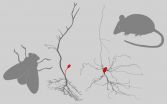(Press-News.org) CAMBRIDGE, Mass. -- MIT physicists have developed a new tabletop particle detector that is able to identify single electrons in a radioactive gas.
As the gas decays and gives off electrons, the detector uses a magnet to trap them in a magnetic bottle. A radio antenna then picks up very weak signals emitted by the electrons, which can be used to map the electrons' precise activity over several milliseconds.
The team worked with researchers at Pacific Northwest National Laboratory, the University of Washington, the University of California at Santa Barbara (UCSB), and elsewhere to record the activity of more than 100,000 individual electrons in krypton gas.
The majority of electrons observed behaved in a characteristic pattern: As the radioactive krypton gas decays, it emits electrons that vibrate at a baseline frequency before petering out; this frequency spikes again whenever an electron hits an atom of radioactive gas. As an electron ping-pongs against multiple atoms in the detector, its energy appears to jump in a step-like pattern.
"We can literally image the frequency of the electron, and we see this electron suddenly pop into our radio antenna," says Joe Formaggio, an associate professor of physics at MIT. "Over time, the frequency changes, and actually chirps up. So these electrons are chirping in radio waves."
Formaggio says the group's results, published in Physical Review Letters, are a big step toward a more elusive goal: measuring the mass of a neutrino.
A ghostly particle
Neutrinos are among the more mysterious elementary particles in the universe: Billions of them pass through every cell of our bodies each second, and yet these ghostly particles are incredibly difficult to detect, as they don't appear to interact with ordinary matter. Scientists have set theoretical limits on neutrino mass, but researchers have yet to precisely detect it.
"We have [the mass] cornered, but haven't measured it yet," Formaggio says. "The name of the game is to measure the energy of an electron -- that's your signature that tells you about the neutrino."
As Formaggio explains it, when a radioactive atom such as tritium decays, it turns into an isotope of helium and, in the process, also releases an electron and a neutrino. The energy of all particles released adds up to the original energy of the parent neutron. Measuring the energy of the electron, therefore, can illuminate the energy -- and consequently, the mass -- of the neutrino.
Scientists agree that tritium, a radioactive isotope of hydrogen, is key to obtaining a precise measurement: As a gas, tritium decays at such a rate that scientists can relatively easily observe its electron byproducts.
Researchers in Karlsruhe, Germany, hope to measure electrons in tritium using a massive spectrometer as part of an experiment named KATRIN (Karlsruhe Tritium Neutrino Experiment). Electrons, produced from the decay of tritium, pass through the spectrometer, which filters them according to their different energy levels. The experiment, which is just getting under way, may obtain measurements of single electrons, but at a cost.
"In KATRIN, the electrons are detected in a silicon detector, which means the electrons smash into the crystal, and a lot of random things happen, essentially destroying the electrons," says Daniel Furse, a graduate student in physics, and a co-author on the paper. "We still want to measure the energy of electrons, but we do it in a nondestructive way."
The group's setup has an additional advantage: size. The detector essentially fits on a tabletop, and the space in which electrons are detected is smaller than a postage stamp. In contrast, KATRIN's spectrometer, when delivered to Karlsruhe, barely fit through the city's streets.
Tuning in
Furse and Formaggio's detector -- an experiment called "Project 8" -- is based on a decades-old phenomenon known as cyclotron radiation, in which charged particles such as electrons emit radio waves in a magnetic field. It turns out electrons emit this radiation at a frequency similar to that of military radio communications.
"It's the same frequency that the military uses -- 26 gigahertz," Formaggio says. "And it turns out the baseline frequency changes very slightly if the electron has energy. So we said, 'Why not look at the radiation [electrons] emit directly?'"
Formaggio and former postdoc Benjamin Monreal, now an assistant professor of physics at UCSB, reasoned that if they could tune into this baseline frequency, they could catch electrons as they shot out of a decaying radioactive gas, and measure their energy in a magnetic field.
"If you could measure the frequency of this radio signal, you could measure the energy potentially much more accurately than you can with any other method," Furse says. "The problem is, you're looking at this really weak signal over a very short amount of time, and it's tough to see, which is why no one has ever done it before."
It took five years of fits and starts before the group was finally able to build an accurate detector. Once the researchers turned the detector on, they were able to record individual electrons within the first 100 milliseconds of the experiment -- although the analysis took a bit longer.
"Our software was so slow at processing things that we could tell funny things were happening because, all of a sudden, our file size became larger, as these things started appearing," Formaggio recalls.
He says the precision of the measurements obtained so far in krypton gas has encouraged the team to move on to tritium -- a goal Formaggio says may be attainable in the next year or two -- and pave a path toward measuring the mass of the neutrino.
INFORMATION:
This research was funded in part by the Department of Energy and the National Science Foundation.
DURHAM, N.C. - A new study based on 1,000 years of temperature records suggests global warming is not progressing as fast as it would under the most severe emissions scenarios outlined by the Intergovernmental Panel on Climate Change (IPCC).
"Based on our analysis, a middle-of-the-road warming scenario is more likely, at least for now," said Patrick T. Brown, a doctoral student in climatology at Duke University's Nicholas School of the Environment. "But this could change."
The Duke-led study shows that natural variability in surface temperatures -- caused by interactions ...
The study conducted at Sant Pau and Bellvitge hospitals, published in the American journal Molecular Psychiatry and conducted with the use of neuroimaging techniques, demonstrates for the first time that cannabis consumers have a less active hippocampus, a key structure related to the storage of memories.
Consumers of cannabis show distortions in their memories and can even come to imagine situations which differ from reality.
The study compared the memories of consumers to that of non-consumers to find differences in the retention of situations and experiences.
The ...
New research led by NYU Langone Medical Center examines what happens when a patient with multiple sclerosis (MS) who is clinically stable stops taking their medication.
The international, multi-site study found almost 40 percent of patients had some disease activity return when they stopped taking their meds.
The findings were presented at the American Academy of Neurology Annual Meeting held April 18-25, in Washington, D.C.
"Despite long periods of disease stability while taking medication, we found a large minority of patients who stopped experienced relapses or disability ...
PHILADELPHIA - RNA is both the bridge between DNA and the production of proteins that carry out the functions of life and what guides which and how much protein gets made. As messenger RNA (mRNA) is transcribed from DNA to carry genetic information out of the nucleus, segments that don't code for actual proteins need to be removed from the RNA strand and the remaining pieces spliced together. Different pieces of the expressed gene (exons) are cut out, and these sections are joined together to form the final mRNA strand. Cells gain their ability to produce proteins with ...
Over the past 25 years, the construct of situation awareness (SA), or the perception and interpretation of what is happening around you, has been a catalyst for new advances in the human factors/ergonomics field, particularly in the areas of information display, automation, and training.
But recent advances also raise new questions, such as these: To what extent is SA about "awareness in the head" versus "awareness of where to look around you"? How is the process of maintaining SA affected by workload? Is it possible to have high-level SA about, for example, the progress ...
Men with prostate cancer benefit from treatment with the pioneering drug olaparib - the first cancer drug to target inherited mutations - according to the results of a major trial presented today (Tuesday).
Olaparib was licensed in December for women with ovarian cancer and inherited BRCA mutations, but the new research suggests it could also benefit men with genomic faults within their tumours.
Researchers told the American Association of Cancer Research (AACR) conference in Philadelphia that up to 30 per cent of men with advanced prostate cancer had tumours with defects ...
Human activity has removed more than one-tenth of trees and plants from the Amazon rainforest since the 1960s, a study shows.
Widespread removal of trees has contributed to a rise in the amount of carbon dioxide in the atmosphere, increasing the potential impact of climate change, researchers say.
Deforestation of the Amazon accounted for 1.5 per cent of the increase in carbon dioxide levels seen since the mid-nineteenth century, the team says.
However, this increased the total amount of carbon found in the atmosphere only very slightly compared with fossil fuel ...
New research shows that fishing is having a significant impact on the make-up of fish populations of the Great Barrier Reef.
It's long been known that environmental impacts such as climate change and pollution are amongst the drivers of change on the Great Barrier Reef.
Now researchers from the ARC Centre of Excellence for Coral Reef Studies (Coral CoE) at James Cook University have found that removing predatory fish such as coral trout and snapper, through fishing, causes significant changes to the make-up of the reef's fish populations.
"A stable and healthy reef ...
Nerve cells come in very different shapes. Researchers at the Bernstein Center Berlin now reveal why, in insects, the cell body is usually located at the end of a separate extension. Using mathematical models, they show that this increases the strength of electrical signal transmission at no additional energetic cost.
Nerve cells follow a functional design: They receive input signals over more or less ramified cell branches (dendrites), which they forward to other nerve cells along an elongated, thin cell process (axon). The cell body contains the nucleus with genetic ...
A new study has found that internet discussion forums have positive links to well-being and are even associated with increased community engagement offline, contrary to a common perception of them being outdated and prone to trolling.
Research just published in the journal Computers in Human Behavior found that online forums have benefits for both individuals and wider society and are of greater importance than previously realised.
Although seemingly eclipsed in the past decade by social networking sites such as Facebook and Twitter, forums are still regularly used ...


